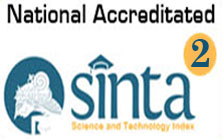Preparedness of Emergency Room Nurses After Emerging Infectious Diseases Screening
DOI:
https://doi.org/10.31965/infokes.Vol21.Iss1.892Keywords:
Emerging Infectious Disease, EID Screening Instrument, Preparedness of Emergency Room NursesAbstract
Emerging infectious diseases (EID) is one of the leading causes of death worldwide since it initially attacks a population or has existed before but is increasing very rapidly in terms of the number of new cases in a population. Early detection of EID patients refers to early screening. Screening of patients with suspected EID such as Covid-19 or other airborne infectious diseases must be performed at the first contact with suspected patients. This study aims to evaluate the effectiveness of EID screening instrument applied at the Emergency Room (ER). This was a quantitative pre-experimental study with a one-group pretest-posttest design. The sample size consisted of 34 nurses at the ER of Mangusada Hospital, Bali, who were selected using a total sampling technique. The intervention administered in this study was the implementation of EID screening instrument before the patients entered triage for 1 month on June 2022 at the ER of Mangusada Hospital. After ensuring the distribution and homogeneity of the data, a paired t-test was employed for parametric statistical data analysis. The result of the study showed a p-value of (0.004) or p <α (0.05). So, it can be concluded that there was an effect of the screening instrument applied at the ER of Mangusada Hospital on the preparedness of nurses in dealing with EID. Thus, the screening for patients with EID should be implemented in each emergency unit. The study finding can help improve nurse preparedness regarding the prevention of EID. In addition, future study is recommended to assess the competence of nurses regarding the prevention of EID.
Downloads
References
AK, I. Y. D. Pengembangan sistem kewaspadaan dini penyakit new-emerging dan re-emerging, studi kasus pada penyakit mers-cov dan ebola di kantor kesehatan pelabuhan soekarno-hatta. Journal of Information Systems for Public Health, 4(1), 1-8. https://doi.org/10.22146/jisph.12329
Al Baalharith, I. M., & Pappiya, E. M. (2021). Nurses' preparedness and response to COVID-19. International Journal of Africa Nursing Sciences, 14, 100302. https://doi.org/10.1016/j.ijans.2021.100302
Alzahrani, F., & Kyratsis, Y. (2017). Emergency nurse disaster preparedness during mass gatherings: a cross-sectional survey of emergency nurses' perceptions in hospitals in Mecca, Saudi Arabia. BMJ open, 7(4), e013563. Retrieved from https://bmjopen.bmj.com/content/7/4/e013563.abstract
Atkeson, A., Droste, M. C., Mina, M., & Stock, J. H. (2020). Economic benefits of COVID-19 screening tests (No. w28031). National Bureau of Economic Research. https://doi.org/10.3386/w28031
Beeres, D. T., Cornish, D., Vonk, M., Ravensbergen, S. J., Maeckelberghe, E. L., Boele Van Hensbroek, P., & Stienstra, Y. (2018). Screening for infectious diseases of asylum seekers upon arrival: the necessity of the moral principle of reciprocity. BMC Medical Ethics, 19(16), 1-7. https://doi.org/10.1186/s12910-018-0256-7
Bloom, D. E., Black, S., & Rappuoli, R. (2017). Emerging infectious diseases: A proactive approach. Proceedings of the National Academy of Sciences, 114(16), 4055-4059. https://doi.org/10.1073/pnas.170141011
Chen, Shu-Ching, Yeur-Hur, L. A. I., & Shiow-Luan, T. S. A. Y. (2020). Nursing perspectives on the impacts of COVID-19. Journal of Nursing Research, 28(3), e85. https://doi.org/10.1097/jnr.0000000000000389
Choi, J. S., & Kim, J. S. (2018). Factors influencing emergency nurses’ ethical problems during the outbreak of MERS-CoV. Nursing ethics, 25(3), 335-345. https://doi.org/10.1177/0969733016648205.
Coker, R. J., Hunter, B. M., Rudge, J. W., Liverani, M., & Hanvoravongchai, P. (2011). Emerging infectious diseases in southeast Asia: regional challenges to control. The Lancet, 377(9765), 599-609. https://doi.org/10.1016/S0140-6736(10)62004-1
El‐Monshed, A. H., Amr, M., Ali, A. S., Elmasry, Y. M., & Zoromba, M. (2021). Nurses' knowledge, concerns, perceived impact and preparedness toward COVID‐19 pandemic: A cross‐sectional survey. International journal of nursing practice, 27(6), e13017. https://doi.org/10.1111/ijn.13017.
Emaliyawati, E., Ibrahim, K., Trisyani, Y., Mirwanti, R., Ilhami, F. M., & Arifin, H. (2021). Determinants of nurse preparedness in disaster management: a cross-sectional study among the community health nurses in coastal areas. Open access emergency medicine, 13, 373-379. https://doi.org/10.2147/OAEM.S323168.
Gostic, K. M., Kucharski, A. J., & Lloyd-Smith, J. O. (2015). Effectiveness of traveller screening for emerging pathogens is shaped by epidemiology and natural history of infection. Elife, 4, e05564. https://doi.org/10.7554/eLife.05564
Hensgens, K. R., van Rensen, I. H., Lekx, A. W., van Osch, F. H., Knarren, L. H., Wyers, C. E., ... & Barten, D. G. (2021). Sort and sieve: pre-triage screening of patients with suspected COVID-19 in the emergency department. International Journal of Environmental Research and Public Health, 18(17), 9271. https://doi.org/10.3390/ijerph18179271
Iragorri, N., & Spackman, E. (2018). Assessing the value of screening tools: reviewing the challenges and opportunities of cost-effectiveness analysis. Public health reviews, 39(1), 1-27. https://doi.org/10.1186/s40985-018-0093-8
Laksmi, I. A. A., & Susila, I. M. D. P. (2022). Validity and Reliability of the Nurse Preparedness Questionnaire in Facing Emerging Infectious Diseases. Nursing and Health Science Journal (NHSJ), 2(3), 240-243. https://doi.org/10.53713/nhs.v2i3.157
Mcgonagle, D. (2020). Since January 2020 Elsevier has created a COVID-19 resource centre with free information in English and Mandarin on the novel coronavirus COVID-19. The COVID-19 resource centre is hosted on Elsevier Connect, the company‘s public news and information.
Millán, R., Thomas-Paulose, D., & Egan, D. J. (2018). Recognizing and managing emerging infectious diseases in the emergency department. Emergency medicine practice, 20(5), 1-20. Retrieved from https://europepmc.org/article/med/29697919
Morens, D. M., & Fauci, A. S. (2020). Emerging pandemic diseases: how we got to COVID-19. Cell, 182(5), 1077-1092. https://doi.org/10.1016/j.cell.2020.08.021
Mahdi, M., & Mudatsir, N. (2014). Kesiapsiagaan Perawat Dalam Menghadapi Wabah Flu Burung Di Instalasi Gawat Darurat Rumah Sakit Umum Daerah Dr. Zainoel Abidin Banda Aceh. Jurnal Ilmu Kebencanaan: Program Pascasarjana Unsyiah, 1(2), 22-27. Retrieved from https://jurnal.usk.ac.id/JIKA/article/view/5597
Nie, A., Su, X., Dong, M., & Guan, W. (2022). Are nurses prepared to respond to next infectious disease outbreak: A narrative synthesis. Nursing Open, 9(2), 908-919. https://doi.org/10.1002/nop2.1170
Palagyi, A., Marais, B. J., Abimbola, S., Topp, S. M., McBryde, E. S., & Negin, J. (2019). Health system preparedness for emerging infectious diseases: a synthesis of the literature. Global Public Health, 14(12), 1847-1868. https://doi.org/10.1080/17441692.2019.1614645
Presiden Republik Indonesia. (2007). Undang Undang Republik Indonesia Nomor 24 Tahun 2007 Tentang Penaggulangan Bencana. Retrieved from https://peraturan.bpk.go.id/Home/Details/39901/uu-no-24-tahun-2007
Qadri, U., Elida, S. S & Larasati, F. (2021). Mitigation Models and Strategies Corona Virus Disease 2019 (COVID19) Non-Natural Disasters (Study on BPBD of West Kalimantan Province). Publik (Jurnal Ilmu Administrasi), 10(1), 109-125. http://dx.doi.org/10.31314/pjia.10.1.109-125.2021
Rochani, S. (2021). Hubungan Tingkat Pendidikan dan Lama Kerja dengan Waktu Tanggap Perawat di Instalasi Gawat Darurat RSUD Dr. Adjidarmo Rangkasbitung. Jurnal Kesehatan Saelmakers PERDANA, 4(2), 221-229. Retrieved from https://journal.ukmc.ac.id/index.php/joh/article/view/269
Sikatta, F. O. A., & Adisasmito, W. B. B. (2020). Resiko Perilaku Konsumsi Satwa Liar Terhadap Kejadian Penyakit Infeksi Emerging (PIE): Tinjauan Literatur. IAKMI Jurnal Kesehatan Masyarakat Indonesia, 1(3), 143-150. Retrieved from http://jurnal.iakmi.id/index.php/IJKMI/article/view/119#
Sub Direktorat Penyakit Infeksi Emerging, K. (2023). Mengenal Penyakit Infeksi Emerging [Internet}. Sub Direktorat Penyakit Infeksi Emerging, Kementerian Kesehatan Republik Indonesia. Retrieved from https://infeksiemerging.kemkes.go.id/mengenal-penyakit-infeksi-emerging.
Susila, I. M. D. P., & Laksmi, I. A. A. (2022). Prevalence and Associated Factors of Burnout Risk among Emergency Nurses during COVID-19 Pandemic. Babali Nurs. Res, 3(1), 7-14. https://doi.org/10.37363/bnr.2022.3169
Vinet, L., & Zhedanov, A. (2011). A ‘missing’family of classical orthogonal polynomials. Journal of Physics A: Mathematical and Theoretical, 44(8), 085201. https://doi.org/10.1088/1751-8113/44/8/085201
WHO. (2018). Infection Prevention and Control Assessment Framework at The Facility Level. Geneva: World Health Organization. Retrieved from https://www.who.int/publications/i/item/WHO-HIS-SDS-2018.9
Yaffee, A. Q., Isakov, A., & Wu, H. M. (2019). How can emergency departments better prepare for emerging infectious disease threats? A returned traveler with fever walks into triage…. Journal of Emergency Medicine, 56(5), 568-570. https://doi.org/10.1016/j.jemermed.2018.12.049
Downloads
Published
How to Cite
Issue
Section
License
Copyright (c) 2023 JURNAL INFO KESEHATAN

This work is licensed under a Creative Commons Attribution-NonCommercial-ShareAlike 4.0 International License.
Copyright notice
Ownership of copyright
The copyright in this website and the material on this website (including without limitation the text, computer code, artwork, photographs, images, music, audio material, video material and audio-visual material on this website) is owned by JURNAL INFO KESEHATAN and its licensors.
Copyright license
JURNAL INFO KESEHATAN grants to you a worldwide non-exclusive royalty-free revocable license to:
- view this website and the material on this website on a computer or mobile device via a web browser;
- copy and store this website and the material on this website in your web browser cache memory; and
- print pages from this website for your use.
- All articles published by JURNAL INFO KESEHATAN are licensed under the Creative Commons Attribution 4.0 International License. This permits anyone to copy, redistribute, remix, transmit and adapt the work provided the original work and source is appropriately cited.
JURNAL INFO KESEHATAN does not grant you any other rights in relation to this website or the material on this website. In other words, all other rights are reserved.
For the avoidance of doubt, you must not adapt, edit, change, transform, publish, republish, distribute, redistribute, broadcast, rebroadcast or show or play in public this website or the material on this website (in any form or media) without appropriately and conspicuously citing the original work and source or JURNAL INFO KESEHATAN prior written permission.
Permissions
You may request permission to use the copyright materials on this website by writing to jurnalinfokesehatan@gmail.com.
Enforcement of copyright
JURNAL INFO KESEHATAN takes the protection of its copyright very seriously.
If JURNAL INFO KESEHATAN discovers that you have used its copyright materials in contravention of the license above, JURNAL INFO KESEHATAN may bring legal proceedings against you seeking monetary damages and an injunction to stop you using those materials. You could also be ordered to pay legal costs.
If you become aware of any use of JURNAL INFO KESEHATAN copyright materials that contravenes or may contravene the license above, please report this by email to jurnalinfokesehatan@gmail.com
Infringing material
If you become aware of any material on the website that you believe infringes your or any other person's copyright, please report this by email to jurnalinfokesehatan@gmail.com.



















